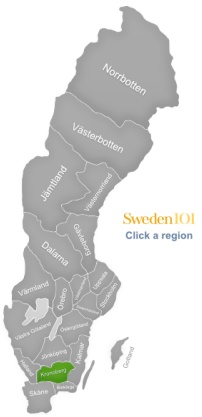Kronoberg - Växjö

What does the name of the region mean?
The Kronoberg region received its name from Kronoberg castle which used to be a very important defense against invading Danish troops. The meaning of Kronoberg might be translated as crown mountain, but the actual etymology of the name is not 100% clear.
What is the region's historical importance?
As the region was named after the castle Kronoberg, you can safely assume that the region's importance was tightly tied to the castle itself. Today, this is not so much the case any longer as the Swedish do not have to defend themselves against invading Danish armies, but in the past, castle Kronoberg was a very important defense until the Swedish gained the control over the Southern regions.
What is the region known for?
The region of Kronoberg, the city of Växjö to be precise, is known for its achievements when it comes to reducing the use of fossil fuels. In recent years, the city has reduced the amount of fossil fuels it used immensely, and even though others predicted that this would mean economic distaster for the region, the opposite happened. Hence Växjö is a fantastic role model for other cities and regions who would like to adopt an environmentally friendly approach and yet still be economically successful.
What are some places you need to visit in Kronoberg?
Växjö
Växjö is the capital of Kronoberg. The name means road over the lake, and some also translate it as road over the frozen lake, but that might stretch it a little, as the word sjö is usually simply translated as lake. The city was important during the Dacko war, but in general was rather quiet. It was the victim of numerous fires in the past until a new plan for the city was developed in 1843. The street plan is the same you still see today.
Växjö's highest building is one of the most popular tourist attractions in the city: the Växjö Cathedral. It is 63 meters high, and one very good example of medieval churches in Sweden. It's characteristic double towers can be seen from different places in Växjö, and the cathedral is open for visitors every day.
The Teleborg Water Tower
The Teleborg Water Tower, also located in Växjö, has recently also become interesting to tourists. It actually wasn't intended as an attraction in itself, just simply as a water tower, but then someone discovered that any sound you make under the tower has a really intense echo. You will often find people under the Teleborg Water Tower, throwing stones, making funny noises or just singing, and then listen to the echo. It's not a normal attraction but definitely worth your time if you would like to have some crazy fun.
Teleborg Castle
Teleborg Castle was originally built to be a wedding present for the wife of count Fredrik Bonde af Björnö. A rather generous wedding present, wouldn't you say? Today, the castle is used as a restaurant and for conferences. On Sundays, you can visit the castle in the afternoon to have a cup of coffee. For lunches, you need to book in advance. Accommodation is also available, but also has to be booked well in advance.
Kronoberg Castle
Kronoberg Castle is definitely the most important place to visit in the region of Kronoberg. In the past, the castle was very important when it came to defending the country against the invading Danes. After all, parts of today's Sweden were then under Danish rule. The castle was originally just a stone house, and quickly destroyed by the Danes. Later on, it was rebuilt as a proper fortress, and served well in the war against the Danes. However, when the Southern regions of Sweden were handed over to Sweden, and the Danish were not a direct threat any longer, the castle was neglected, and over time – as you expected it – turned into the ruins you can still visit today. They are scenic ruins, of course, and on a good day the location offers you stunning photo opportunities.

_(2).jpg)